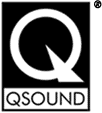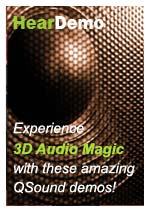Audio Effects Technology
While there is no precise definition of constitutes an audio effect, effects typically add something to the signal that wasn’t originally present. This distinguishes them from controls such as volume and tone, which alter existing aspects of the signal.
Certain audio effects are, by default, included with products such as microQ and microQ JSR-234. All effects are available for custom integration.
Delay (Echo)
In the physical world, an echo occurs when reflected sound waves reach a listener after the original sound is heard, and the resulting delay is long enough that the listener perceives the repetition as a distinct repeat. The delay time is a function of the additional path length that reflections travel to reach the listener. By creating copies of a signal delayed by 100ms (0.1sec) or more, and adding them to the output at reduced volume, the effect of echoes can readily be emulated.
Reverberation
Each time sound waves reflect off a surface, energy is lost and the character of the sound is altered to a degree depending on the nature of the reflecting surface. As waves bounce repeatedly off multiple objects, they become increasingly noise-like as they decay. Reverberation or “reverb” is essentially composed of multiple overlapping echoes, forming a wash of sound that follows the original excitation of the space.
Reverberation communicates a great deal about the character of the space to the listener. The reverb experienced inside a well-designed concert hall or church is dramatically different from the reverb inside a living room or a stone corridor.
Digitally-simulated reverberation can realistically emulate the characteristic sound of various acoustic environments.
Chorusing
When multiple instruments or voices play or sing the same notes, inevitably there are slight differences in pitch that tend to vary somewhat over time. Far from being a flaw, the minor, shifting variations are the very reason that ensemble performance sounds so thick and rich.
Chorusing is an effect that emulates ensemble playing, using copies of the original signal delayed by several milliseconds. The delay amount is slowly and smoothly varied to simulate the slight drift of human performers.
Phasing
Perhaps you have noticed how the sound of a jet passing overhead slowly changes in tone, or how this change in tone can be played with if you alter the distance between your head and the ground.
The direct sound of the plane is heard in addition to a very slightly delayed version of the same sound, bouncing off the ground. Although this is similar to the creation of echoes, because the distance from the listener to the sound generator is so great, and the additional distance traveled by the sound waves to reflect off the ground and reach your ears relatively small, the result is two signals of nearly the same level that are only very slightly time-shifted relative to each other, so they perceived as a single sound rather than a sound followed by a discrete echo.
As the two sets of sound waves combine, the slight time delay results in varying degrees of phase shift such that certain frequencies are reinforced (as their wave components add together) and certain frequencies are suppressed (as their wave components tend to cancel each other). As distance changes with the position of the jet or the listener’s head, the peaks and valleys in the frequency response move through the spectrum, resulting in the characteristic gentle whooshing effect.
The phasing (a.k.a. phaser or phase shifter) effect emulates this characteristic.
Distortion
While distortion is generally to be avoided in audio systems, purposely-applied and carefully controlled forms of distortion can be both musical and useful, as any electric guitar player knows.

